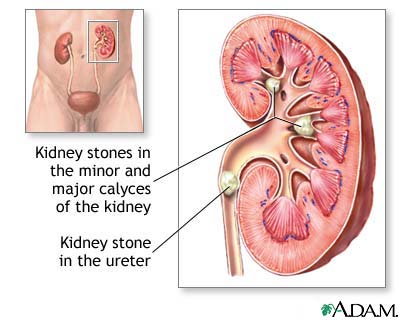
A kidney stone is a hard, crystalline mineral material formed within the kidney or urinary tract. It is one of the most painful problems of urinary tract. A kidney stone is a solid mass made up of tiny crystals. one or more stones can be in the kidney or ureter at the same time. Kidney stones, usually comprised of a compound called calcium oxalate, are the result of a build-up of dissolved minerals on the inner lining of the kidneys. Kidney stones often occur when urine becomes too concentrated.
Kidney stones consist of a center that consists of crystal-like substances and a surrounding region that is composed of layers. Different kinds of kidney stones include calcium stones, uric acid stones, cystine stones and struvite stones. Kidney stones are experienced between the ages of 30 and 50.
- Urine contains certain substances which converts into crystals.- Lack of water.- an excessively acidic environment in the kidneys is conducive to the formation of kidney stones.- Heredity.- Intake of certain foods results in too much of certain stone-forming components in the urine.- Bowel disease.- Chronic urinary tract infections.- Urinary tract blockage.- Minimal activity.
- Intense, colicky pain that may fluctuate in intensity over a period of 5 to 15 minutes. The pain usually starts in your back or your side just below the edge of your ribs.- Severe Pain.- Nausea and Vomiting.- Blood in the urine.- Increase in frequency or urgency of urination, or the inability to urinate.- Fever, chills and weakness.- Cloudy or foul-smelling urine.- Pus in urine.
- Diagnostic tests include a blood test, a urine test and a 24-hour urine collection test.- Kidney-ureter-bladder (KUB) x-ray, a kidney ultrasound, an intravenous pyelogram (IVP) and if recommended, a CAT (CT) scan.
- about 90 percent of all kidney stones can pass through the urinary system spontaneously with the help of plenty of water (two to three quarts a day) to help the stone move along.- Pain medications.- Extracorporeal shockwave lithotripsy (ESLW) – Shock waves generated in water (like very tiny tidal waves) can be very precisely directed into the abdomen to break up the stone into smaller particles that can be easily passed in the urine.- Percutaneous nephrolithotomy – This method makes use of a tunnel-like surgical device that is inserted into a small hole in the patient’s back and positioned on the kidney.- Ureteroscopy – When the stone is located in the ureter, this device, which looks like a wire, is inserted into the patient’s urethra and threaded through the bladder and up the ureter to where the stone is lodged.
- Previous Entry: Peptic Ulcer – Diagnosis, Treatment and Home Remedies and Complications
- Next Entry: Causes and Symptoms of Ear Wax Blockage and how this can be treated?